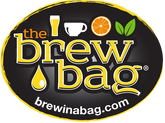In a recent article discussing different methods of brewing, the author differentiated "all-grain" from Brew In A Bag. I had to read the sentence twice. BIAB does not use extract, does not come in a kit, (although Brewer's Best is now offering six BIAB kits that include the hops, grain, priming sugar, yeast, and caps) and utilizes the same mashing schedule as the "all grain" method. Now here's the kicker - to make beer using a brew bag you start with grain, that's right, BIAB uses nuttin but grain!
I'll tell you what's happening across the USA - new and old brewer's alike are beginning to realize how down-right easy brewing using a bag really is. Just today I saw a post on Facebook from a guy who brewed side-by-side with a three tier guy over the weekend. Here's what he said "Oh, and I finished chilling mine, racked over a beer to use the yeast cake, ran uptown to get hot dog buns, and grilled brats and chicken breasts while he was finishing!
Ahem - while the three tier guy was finishing his brew "day", the BIAB guy was feeding his family after a trip uptown. Most BIAB guys say they are wrapped up in 3.5 hours or so from start to finish including clean up.
So what about the stand differences? The 3V set up is either staggered vertical on three levels, each higher than the other, or horizontal and must use pumps. They are made of wood or metal and generally are about five feet long. The vertical gravity fed design feeds the next lower level with the top tier kettle opening above an average height man's reach. Most use two burners; one for heating water and one for heating wort. If the brewer only has one burner, the kettle with wort must be lifted and moved to the burner. I've seen all sorts of unsafe set-ups as brewers forego the stand and use blocks, or their counter tops, or whatever they can find to make it work.
Three vessel / tier brewers must sparge as well. Sparging is a process by which hot water is sprinkled, drizzled, or poured onto the grain bed after mashing. This pushes the wort through the mash tun and out into the boil kettle. Depending on the method used it can take thirty to ninety minutes and requires the brewer to be ever present during the process. After sparging the process is the same.
Brew In A Bag uses one burner, one kettle, and the bag. Effectively it is a no-sparge method of brewing. No-sparge has been widely criticized as lacking effectiveness in washing "all" the sugars out of the grain bed, but, efficiency is in the kettle of the beholder. True, there is sugar left behind in the bag - but it's not needed, and there is also sugar left behind in a 3V process. Three tiers guys struggle with this as they have been taught that the slow careful sparge process is the key to complete sugar transfer - and they are right. But at what point do you trade 60 to 90 minutes for a few points on the hydrometer?
Remember the guy who ran uptown, grilled out and was feeding his family while the three tier guy was finishing his brew "day"?
Oh yeah, I left off after describing the BIAB set up and process. So, you put water in a kettle, heat it, drop the bag in, dump the grain in, wait an hour, lift the bag, boil the wort, chill the wort, put the yeast in, and then go uptown for the hot dog buns.

I brewed with the Brew Bag this past weekend and I think sparging over the Bag is a waste of time. My recipe called for OG between 1.046 to 1.050. My measured OG was 1.052. I admit I tried sparging over a previous cheap brew bag and didn’t see any increase in Gravity. So I dont do it. I Mill my grains at.23 which is pretty fine but no need to worry Brew Bag is a great filter. Beer club agrees that my beer is good.
You forgot to mention that one can also use a second kettle for sparging with BIAB, thus further making arguments in favor of 3 tier systems moot.